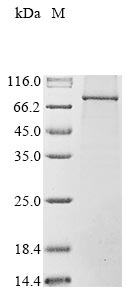Recombinant Human Nuclear cap-binding protein subunit 1 (NCBP1) is expressed in a baculovirus system, covering the full length of 1-790 amino acids. The protein carries an N-terminal 10xHis-tag and a C-terminal Myc-tag, which streamline purification and detection in experimental applications. SDS-PAGE analysis indicates the product achieves greater than 85% purity, making it suitable for various research applications that demand high-quality reagents.
NCBP1 appears to be an essential component of the cap-binding complex and plays a critical role in mRNA processing and stability. The protein is involved in the initial steps of mRNA transport from the nucleus to the cytoplasm and is vital for efficient mRNA splicing and translation. NCBP1's function in these pathways makes it an important protein for studies on gene expression regulation and cellular response mechanisms.
Potential Applications
Note: The applications listed below are based on what we know about this protein's biological functions, published research, and experience from experts in the field. However, we haven't fully tested all of these applications ourselves yet. We'd recommend running some preliminary tests first to make sure they work for your specific research goals.
Human NCBP1 is a eukaryotic protein that requires precise folding, proper dimerization with NCBP2 (CBP20), and specific tertiary structure for its functional activity in mRNA cap binding and nuclear export. The baculovirus expression system provides a eukaryotic environment that supports proper folding, disulfide bond formation, and post-translational modifications. The dual N-terminal 10xHis-tag and C-terminal Myc-tag are relatively small compared to the full-length protein (790 aa, ∼87 kDa) and may cause minimal steric interference. While the full-length protein contains all functional domains, the probability of correct folding with functional cap-binding activity requires experimental validation, particularly regarding proper complex formation with NCBP2.
1. RNA Cap-Binding Complex Assembly and Characterization Studies
This application carries a significant risk without functional validation. CBC complex formation requires precise heterodimerization with NCBP2. If correctly folded and able to form functional complexes with NCBP2 (verified), the protein is suitable for assembly studies. If misfolded/unable to dimerize properly (unverified), complex assembly data will be biologically meaningless.
2. mRNA Cap Structure Binding Assays
This application requires functional validation. Cap-binding activity requires proper heterodimerization with NCBP2, as NCBP1 alone has weak cap affinity. If correctly complexed with NCBP2 (verified), suitable for binding studies; if improperly folded or alone (unverified), binding data will not reflect physiological cap recognition.
3. Antibody Development and Validation
This application is highly suitable as antibody development relies on antigenic sequence recognition rather than functional complex formation. The full-length protein provides comprehensive epitope coverage for generating NCBP1-specific antibodies.
4. Protein-Protein Interaction Screening
This application carries a moderate risk. NCBP1 interactions with RNA processing factors require native conformation and proper CBC complex formation. If correctly folded and complexed (verified), it may identify genuine partners; if misfolded/unverified, risk of non-specific binding or tag-mediated artefacts.
5. Structural and Biophysical Characterization Studies
These studies are essential for quality control but have limitations. Biophysical analysis can assess folding state, but structural studies of NCBP1 alone will not reflect the physiological CBC heterodimer. Results will describe the monomeric protein rather than the functional complex.
Final Recommendation & Action Plan
The baculovirus-expressed NCBP1 with small dual tags has a high probability of correct folding due to the eukaryotic expression system, but its functional applications are limited by the essential requirement for heterodimerization with NCBP2 to form the functional cap-binding complex. Begin with validation of CBC complex formation through co-immunoprecipitation with NCBP2 and functional cap-binding assays before considering Applications 1, 2, and 4. Application 3 (antibody development) can proceed immediately. Application 5 provides basic characterization but cannot reveal native CBC structure. For reliable NCBP1 research, co-express with NCBP2 in baculovirus to generate the functional heterodimer and validate cap-binding activity before functional studies.






